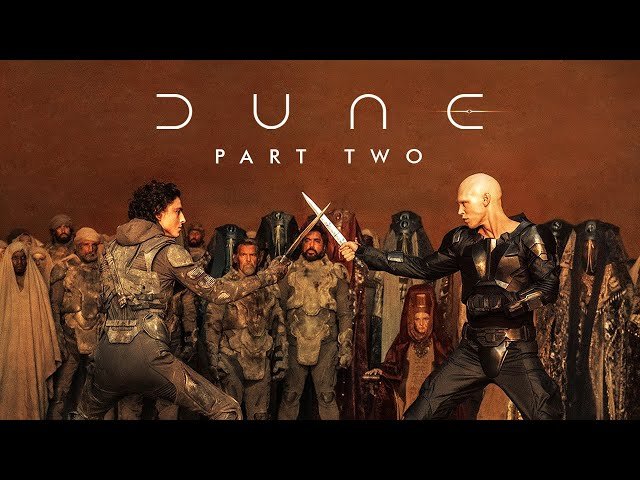Dune: Part Two is not just a sequel—it’s an event. It’s the kind of film that demands attention, consumes conversation, and leaves viewers clamoring for more. Director Denis Villeneuve has not only met expectations with this follow-up to his 2021 sci-fi epic, but he has also surpassed them, delivering a sprawling, visually arresting, and emotionally charged film that solidifies Dune as a landmark in modern cinema.
For fans of the first installment, the anticipation surrounding Dune: Part Two has been palpable. Would it live up to the hype? Could Villeneuve faithfully capture the dense world and intricate political web woven by Frank Herbert in his original novels? The short answer: yes. But it’s so much more than that. This movie doesn’t just “live up to the hype”—it transcends it, emerging as an instant classic that will surely be a benchmark for science fiction storytelling for years to come.
Let’s break down why Dune: Part Two is one of the most exhilarating movie experiences of recent times.
A World Expanded: The Plot Unfolds
Where the first movie laid the foundation, introducing us to the arid planet of Arrakis and its bitterly contested spice trade, Dune: Part Two plunges deeper into the sand-swept dunes, sharpening the focus on Paul Atreides (Timothée Chalamet) and his rise to power. Picking up immediately where the first left off, we find Paul still grappling with the loss of his father and the weight of his growing role as a messianic figure for the oppressed Fremen people.
As Paul joins forces with Chani (Zendaya) and the Fremen, the scope of the story expands to new dimensions, weaving together intricate political strategies, epic battles, and personal sacrifices. The journey from Paul’s reluctant acceptance of his destiny to his full-blown transformation into Muad’Dib—the Fremen’s prophesied leader—is at the heart of the narrative. And it is in this transformation that Dune: Part Two shines, grounding its larger-than-life conflicts in deeply personal stakes.
What’s impressive is how Villeneuve handles the dense source material, streamlining Herbert’s complex political and philosophical ideas while still respecting their depth. The political intrigue that pulses through the film is every bit as gripping as the massive battle sequences. The machinations of the Emperor, the betrayals, and the rise of the desert rebellion are all presented with careful nuance, leaving the audience fully invested in the fate of Arrakis.
Timothée Chalamet’s Star Turn
Timothée Chalamet delivers a performance that is nothing short of electric. In Part Two, we see Paul Atreides as a man truly torn between two worlds: the naive aristocrat he once was and the hardened leader he is becoming. Chalamet’s portrayal of Paul’s evolution is remarkable—he conveys a sense of vulnerability and doubt beneath the surface, even as Paul assumes the mantle of a military and spiritual leader. His internal struggle, which oscillates between moments of intense power and quiet introspection, gives the film an emotional resonance that balances its grander, action-packed sequences.
It’s not just about Paul’s rise to power, though. Dune: Part Two makes room for other characters to shine, particularly Zendaya as Chani. Unlike the first film, where Chani had limited screen time, Zendaya takes on a more prominent role here, stepping into the spotlight as Paul’s love interest and fierce ally. Her portrayal of Chani is captivating—a warrior whose strength and determination provide an anchor for Paul amid the chaos surrounding him.
A Visual and Auditory Feast
Visually, Dune: Part Two is a triumph. Villeneuve’s signature style—his ability to craft jaw-dropping landscapes and immerse viewers in otherworldly settings—reaches new heights here. The sand dunes of Arrakis, with their towering spice harvesters and colossal sandworms, are more vivid and immersive than ever before. Every shot feels deliberate, every frame meticulously composed. From the sweeping desert vistas to the detailed costumes and architecture, the world-building in Dune: Part Two is nothing short of extraordinary.
But it’s not just the visuals that leave a lasting impact. The sound design and score, courtesy of Hans Zimmer, play an integral role in creating the film’s immersive atmosphere. Zimmer’s use of unconventional instruments and guttural, almost primal sounds makes the music feel as integral to the story as the dialogue itself. It’s not often that a film score can make your heart race, but Zimmer’s does just that—whether it’s accompanying a tense moment of political intrigue or an all-out battle sequence. The auditory experience in Dune: Part Two is as much a part of the storytelling as the visuals.
Jaw-Dropping Action Sequences
If there’s one area where Dune: Part Two truly outdoes its predecessor, it’s in the action department. Villeneuve knows how to craft a battle scene, and this film is packed with them. From the brutal skirmishes between Fremen and Harkonnen forces to massive, large-scale set pieces that rival the greatest war films, Dune: Part Two takes the stakes and the intensity to new levels.
The film’s standout sequence—without giving too much away—involves a desert siege that will leave audiences gripping their seats. The choreography of the battles is thrilling, with Villeneuve balancing wide, sweeping shots of armies clashing with up-close, visceral combat that puts viewers right in the middle of the chaos. Each action set piece is impeccably shot and edited, never feeling overstuffed or confusing, but instead driving the narrative forward with propulsive energy.
However, what’s remarkable about these action sequences is how they’re underscored by the weight of the film’s larger themes—power, oppression, and destiny. Villeneuve isn’t just showing off spectacle for the sake of it; every battle, every fight scene, feels deeply connected to the characters’ motivations and the overarching narrative.
A Story of Power, Politics, and Prophecy
At its core, Dune: Part Two is about more than just epic battles and interstellar politics. It’s a meditation on power—who wields it, who suffers under it, and what happens when the lines between savior and conqueror begin to blur. Paul’s journey is a complex one, as he wrestles with the implications of his destiny. Is he truly the savior that the Fremen believe him to be, or is he simply the latest in a long line of imperial figures, destined to subjugate Arrakis under a different banner?
Villeneuve smartly explores these themes without ever feeling heavy-handed. The political dynamics at play—whether between the feuding noble houses, the scheming Bene Gesserit sisterhood, or the Emperor’s court—are presented in a way that feels grounded and real. In the end, it’s the smaller, more intimate moments that give the film its emotional weight, whether it’s Paul’s growing bond with Chani or his strained relationship with his mother, Lady Jessica (Rebecca Ferguson).
The Supporting Cast: A Stellar Ensemble
Dune: Part Two features an ensemble cast that deserves praise across the board. Rebecca Ferguson continues to shine as Lady Jessica, Paul’s mother and a key player in the unfolding political drama. Ferguson expertly navigates Jessica’s inner turmoil, torn between her duties to the Bene Gesserit and her love for her son.
Stellan Skarsgård returns as the grotesque Baron Harkonnen, delivering a chilling performance that solidifies him as one of modern cinema’s most memorable villains. His presence looms large over the film, even when he’s not on screen, reminding us of the ever-present threat to Paul and the Fremen.
Newcomers to the franchise, like Florence Pugh as Princess Irulan and Austin Butler as the ruthless Feyd-Rautha, bring fresh energy to the film. Pugh’s portrayal of Irulan is particularly intriguing—an enigmatic figure who will undoubtedly play a larger role in future installments.
The Final Verdict
In an era where blockbuster films often feel disposable, Dune: Part Two is a breath of fresh air—a movie that demands to be seen on the biggest screen possible, with full attention. It’s a rare combination of high-stakes action, intricate storytelling, and breathtaking artistry. Villeneuve has crafted a cinematic experience that transports viewers to another world while keeping them emotionally invested in the characters and their journeys.
For fans of the first film, Dune: Part Two is a more-than-satisfying continuation. It answers the questions left hanging in the previous installment while setting the stage for future developments. But more than that, it feels like the kind of film that will reward multiple viewings, with its layers of political intrigue, emotional depth, and stunning visual detail.
Whether you’re a die-hard fan of Frank Herbert’s original work or new to the world of Arrakis, Dune: Part Two is an unmissable experience that will leave you eagerly awaiting the next chapter in this epic saga. Villeneuve has once again proven that he is one of the most visionary directors working today, and with Dune: Part Two, he has crafted a masterpiece that will resonate for years to come.
Conclusion: Dune: Part Two is not just another chapter in a sci-fi saga—it’s a cinematic event. With stunning visuals, impeccable performances, and a narrative that resonates on multiple levels, it is undoubtedly one of the most remarkable films of the decade. Don’t miss your chance to witness this masterpiece on the big screen.





